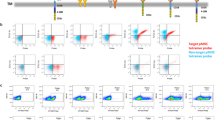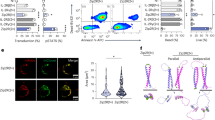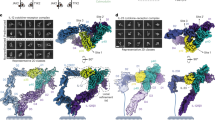Abstract
THE interaction of interleukin-2 (IL-2) and IL-2 receptors criti-cally regulates the T-cell immune response following antigen activation1,2. IL-2 can signal through high or intermediate affinity receptors which contain IL-2Rα (refs 3, 4) + β (refs5–8) + γ (ref. 9) or β + γ chains, respectively. IL-2Rγ is a common γ chain, γc, also shared by the IL-7 (ref. 10) and IL-4 (refs 11,12) receptors, which when mutated results in X-linked severe combined immunodeficiency13. Using chimaeric receptor constructs together with monoclonal or bispecific antibodies we demonstrate here that IL-2 signalling requires ligand-induced extracellular-domain-mediated heterodimerization of the β- and γc-chain cytoplasmic domains. Anti-I L-2Rα monoclonal antibodies trigger proliferation of cells transfected with chimaeric constructs in which the extracel-lular domains of IL-2Rβ and γc are replaced by that of IL-2Rα. Other experiments using chimaeric constructs indicated that IL-2 binds monomerically and monovalently to IL-2Rα and that the β-transmembrane domain is not required for receptor chain inter-actions. Finally, we provide a method for mapping residues in the γc cytoplasmic domain even in cells that constitutively express γc.
This is a preview of subscription content, access via your institution
Access options
Subscribe to this journal
Receive 51 print issues and online access
$199.00 per year
only $3.90 per issue
Buy this article
- Purchase on Springer Link
- Instant access to full article PDF
Prices may be subject to local taxes which are calculated during checkout
Similar content being viewed by others
References
Leonard, W. J., Noguchi, M., Russell, S. M. & McBride, O. W. Immun. Rev. 138, 61–86 (1994).
Minami, Y. & Taniguchi, T. Cell 73, 5–8 (1993).
Leonard, W. J. et al. Nature 311, 625–631 (1984).
Nikaido, T. et al. Nature 311, 631–635 (1984).
Sharon, M., Klausner, R. D., Cullen, B. R., Chizzonite, R. & Leonard, W. J. Science 234, 859–863 (1986).
Tsudo, M., Kozak, R. W., Goldman, C. K. & Waldmann, T. A. Proc. natn. Acad. Sci. U.S.A. 83, 9694–9698 (1986).
Teshigawara, K., Wang, H.-M., Kato, K. & Smith, K. A. J. exp. Med. 165, 223–238 (1987).
Hatakeyama, M. et al. Science 244, 551–556 (1989).
Takeshita, T. et al. Science 257, 379–382 (1992).
Noguchi, M. et al. Science 262, 1877–1880 (1993).
Kondo, M. et al. Science 262, 1874–1877 (1993).
Russell, S. M. et al. Science 262, 1880–1883 (1993).
Noguchi, M. et al. Cell 73, 147–157 (1993).
Otani, H. et al. Proc. natn. Acad. Sci. U.S.A. 89, 2789–2793 (1992).
Cao, X. et al. Proc. natn. Acad. Sci. U.S.A. 90, 8464–8468 (1993).
Kumaki, S. et al. Biochem. biophys. Res. Commun. 193, 356–363 (1993).
Hatakeyama, M. et al. Cell 59, 837–845 (1989).
Exley, M., Terhorst, C. & Wileman, T. Semin. Immun. 3, 283–297 (1991).
Asao, H. et al. Proc. natn. Acad. Sci. U.S.A. 90, 4127–4131 (1993).
Leonard, W. J., Depper, J. M., Robb, R. J., Waldmann, T. A. & Greene, W. C. Proc. natn. Acad. Sci. U.S.A. 80, 6957–6961 (1983).
Leonard, W. J. et al. Nature 300, 267–269 (1982).
Schlessinger, J. & Ullrich, A. Neuron 9, 383–391 (1992).
Stahl, N. & Yancopoulos, G. D. Cell 74, 587–590 (1993).
Kahn, C. R., Baird, K., Flier, J. S. & Jarrett, D. B. J. clin. Invest. 60, 1094–1106 (1977).
Tartaglia, L. A. et al. Proc. natn. Acad. Sci. U.S.A. 88, 9292–9296 (1991).
Francois, C., Boeffard, F., Kaluza, B., Weidle, U. & Jacques, Y. J. Immun. 150, 4610–4619 (1993).
Takebe, Y. et al. Molec. cell. Biol. 8, 466–472 (1988).
Gnarra, J. R. et al. Proc. natn. Acad. Sci. U.S.A. 87, 3440–3444 (1990).
Higuchi, R., Krummel, B. & Saiki, R. K. Nucleic Acids Res. 16, 7351–7367 (1988).
Noguchi, M., Adelstein, S., Cao, X. & Leonard, W. J. J. biol. Chem. 268, 13601–13608 (1993).
Author information
Authors and Affiliations
Rights and permissions
About this article
Cite this article
Nakamura, Y., Russell, S., Mess, S. et al. Heterodimerization of the IL-2 receptor β- and γ-chain cytoplasmic domains is required for signalling. Nature 369, 330–333 (1994). https://doi.org/10.1038/369330a0
Received:
Accepted:
Issue Date:
DOI: https://doi.org/10.1038/369330a0
This article is cited by
-
IL-2 immunotherapy for targeting regulatory T cells in autoimmunity
Genes & Immunity (2023)
-
Strategies to therapeutically modulate cytokine action
Nature Reviews Drug Discovery (2023)
-
Response kinetics reveal novel features of ageing in murine T cells
Scientific Reports (2019)
-
Biology and regulation of IL-2: from molecular mechanisms to human therapy
Nature Reviews Immunology (2018)
-
The common γ-chain cytokine receptor: tricks-and-treats for T cells
Cellular and Molecular Life Sciences (2016)
Comments
By submitting a comment you agree to abide by our Terms and Community Guidelines. If you find something abusive or that does not comply with our terms or guidelines please flag it as inappropriate.



